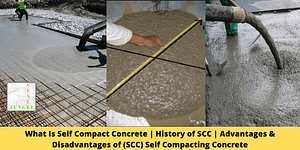Definition
ACI 237 defines Self Compacting Concrete (SCC) as “highly flowable, non-segregating concrete that can spread into place, fill the formwork, encapsulate the reinforcement without any mechanical consolidation.

Idea Of Self Compacting Concrete
SCC idea was brought up by Japanese scientists as they considered following drawbacks which were associated with conventional concrete system
- Mechanical Vibration does not have specified standard which results in non-uniform vibration causing durability and strength to be non-homogeneous.
- Skill full workers were required for mechanical vibration which were not easily available in market
- Conventional mechanical vibration produces noise and it may not be placed round the clock in some areas which restrict the construction time
- Conventional Concrete produces a phenomenon known as white fingers
Properties Of Self Compacting Concrete
- It can be placed very easily such as by pumping and flooding without the need of any mechanical vibration.
- High deformation and flow can be obtained using super plasticizers without compensating on w/c ratio.
- SCC has high segregation resistance, to achieve that water/powder content is kept low or Viscosity Enhancing Agent is used.
Essentials Of SCC
Following are the properties which SCC must have
Filling Ability: The ability of SCC to flow and fill all spaces within formwork under its own weight.
Passing Ability: The ability of SCC to flow through tight openings such as spaces between steel reinforcing bars without segregation and blocking.
Segregation Resistance: SCC should not segregate when poured which means that deformation of aggregate and paste should be uniform.
Concrete Mix Design
Mix design is largely different from conventional systems. More or less it is based on the experience of the engineer who is designing. General Considerations are written below
- Fluidity and viscosity have to be controlled. Fluidity is required, but there should be limits as it will start affecting viscosity. Limitation of water/powder ratio and the addition of viscosity enhancing modifiers give optimal performance.
- Paste act as a vehicle for aggregate grains so paste volume has to be greater than the volume of voids in aggregates. Aggregates should be covered with paste so that lubrication is there and fluidity is enhanced.
- In order to control shrinkage, a significant amount of mineral additions is made which not only control shrinkage but enhance final strength.
- Lower coarse aggregate with the size of about half an inch is used to enhance flowability and passing ability.
- Increased quantity of superplasticizers is used.
- Increased quantity of Viscosity Enhancing Agents is used
Mixing Time
Ingredients of SCC recipe need a slightly higher mixing time as compared to conventional concrete. Mixing time for conventional concrete are usually 32-40 sec and for SCC, a higher mixing time of about 2 minutes is required.
Higher mixing time required for SCC can be attributed to following requirements
- SCC has a high quantity of super plasticizers which requires more time to get activated.
- SCC has more flow which also increases mixing time requirement.
Practical Applications
- SCC was used in Burj Khalifa which is an iconic and tallest building till date. SCC requires comparatively less pumping force and at that much height, it becomes imperative to use SCC for construction.
- SCC is used when Reinforced mesh is fine and mechanical consolidation becomes problematic.
- SCC is used in modern day bridge piers as again for such mass scale it becomes impractical to mechanically vibrate concrete.
- SCC can reduce labour cost, time and noise which can play a crucial role in the overall budget of the project, especially in developing countries where labour cost is high.